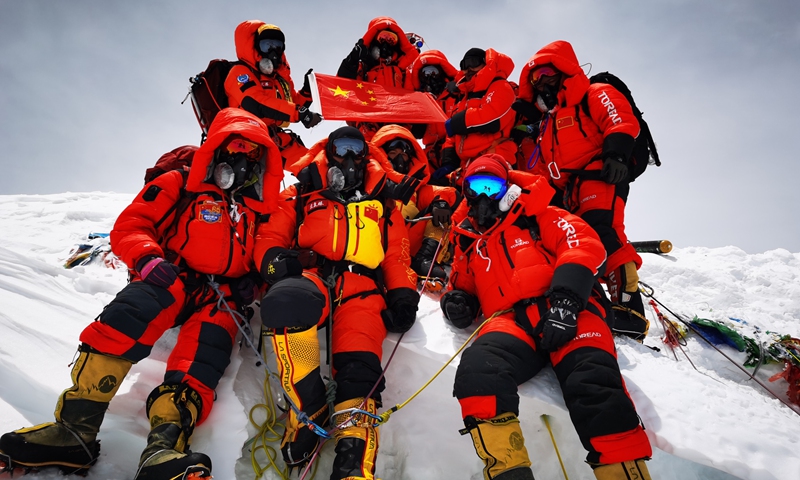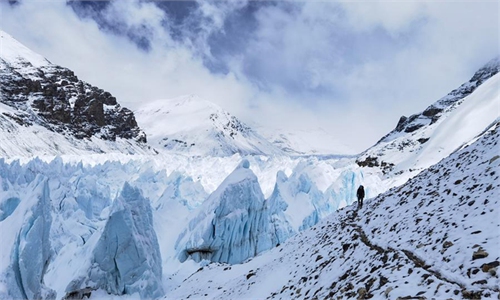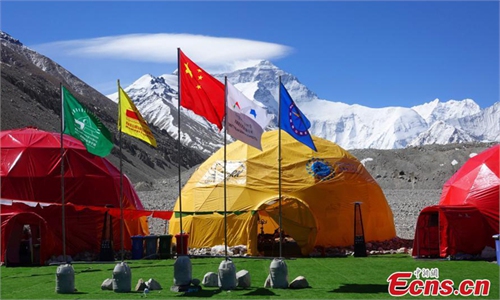Fighting virus on top of the world: China to cordon off north slope atop Mount Qomolangma

Chinese surveyors pose for a group photo atop Mount Qomolangma in 2020. The surveying team reached the summit in 2020 with the trek being a crucial step in the country's mission to re-measure the height of the world's tallest peak. Photo: Xinhua
China will use an "isolation strip" atop Mount Qomolangma to cordon off the north slope of the world's highest mountain, a move to prevent the spread of the coronavirus via climbers ascending from Nepal's side of the mountain, as the latter is being hit by a worsening COVID-19 outbreak.
The so-called isolation strip will be set on the Chinese side, to make sure climbers reaching the top from the north slope make no contact with those ascending from the south slope, Tsering Samdrup, head of the local mountaineering association in Southwest China's Tibet Autonomous Region, told the Global Times on Monday.
The climbing routes from both slopes will be adjusted based on various factors, including weather and road conditions, said Tsering Samdrup, explaining that the chances of climbers from both sides to meet are slim, as they use different routes.
A small team of Tibetan climbing guides will ascend to the Mount Qomolangma and set up the "line of separation" at the summit to stop any contact between mountaineers from both sides of the peak, Nyima Tsering, head of the Tibetan Sports Bureau told the Xinhua News Agency, noting that climbers will be forbidden to touch items such as Hada hung by climbers from the south.
The guides and climbers from the north slope will be equipped with jumpsuits, goggles and oxygen masks to protect them from contracting the virus, said the bureau chief, noting that those people will be disinfected after they descend from the mountain top, and will be isolated if necessary.
Tsering Samdrup said 21 Chinese climbers were approved to attempt to reach the summit from the northern slope. All of them are from low-risk areas, with negative nucleic acid tests, and no foreign climber has been reported since last year, said another member of the association.
Both countries suspended the climbing season on the world's highest mountain last year due to the pandemic. Nepal has issued permits allowing 408 foreigners to attempt climbs this year as it tries to boost tourism revenue.
The Himalayan Rescue Association, which runs a government-led medical clinic at the Qomolangma base camp in Nepal, said last week that it had received confirmation of 17 positive COVID-19 cases in some climbers. Also last week, Nepal halted all flights as part of a strict lockdown of its capital and major cities amid its recent surge.
Maizi Maliyamu, a member of the Chinese expedition team, which is currently at the base camp in Nepal, told the Global Times that there was no "isolation strip" in previous years, and climbers often gave each other high fives or even hugs when they met atop of the mountain from both sides. "It has became a consensus among us."
Yet for Maizi Maliyamu, the "isolation strip" could also mean staggered times of reaching the peak, so that climbers from both slopes won't run into each other.
The only point where climbers from both sides would come close is the summit, which is a small space where climbers spend only a few minutes to take photographs and experience the 360-degree views.
Maliyamu added that despite the ravaging epidemic in the country, Nepal has not banned climbers from summiting the top, and the local Sherpa team in charge of mounting route preparations has already arrived at the peak. Several other teams from various countries, including China, have departed from the base camp and headed to camps at higher altitudes, waiting for the window of the annual summit to open.
Chinese epidemiologists dismissed the possibility of a coronavirus outbreak at the top of the world's highest mountain. Zhuang Shilihe, a Guangzhou-based vaccine expert, told the Global Times that although it is true that the coronavirus can survive longer in low temperatures, it cannot fend off the fatal threat of sun exposure.
Zhuang also said the virus cannot breed in a glacier environment because the lack of hosts, nor can it mutate.
Wu Zunyou, chief epidemiologist of the Chinese Center for Disease Control and Prevention, also said there's no scientific evidence to show that the virus can be sealed up at the mountain top for long periods.
Yet epidemiologists warned that as climbers who choose to ascend from the south slope outnumber those that choose the north, and that Nepal is now ravaged by the coronavirus; strict prevention measures are very necessary to stop the virus from spreading to China from the world's highest peak.



